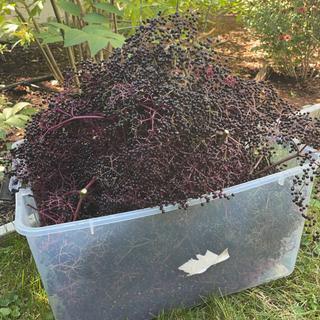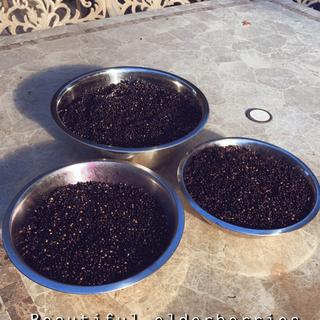Nova Elderberry Plant
Description
An easy-care addition to the edible landscape. Wide clusters of creamy white flowers appear in spring, making wonderful components for bouquets or for dipping in batter and making fritters. If left on the bush, the flowers develop into bountiful bunches of tender, deep purple berries used in jams, jellies, pies, and wines. Being native to North America, these fast-growing bushes also appeal to wildlife, like bees and hummingbirds, as a food source. Cold-hardy. Ripens in early August. Best pollinator: any other elderberry variety.
Note: Elderberries must be cooked before consumption. Consuming fresh elderberries can be toxic. Please ensure all berries are properly prepared before use.
Survival Guaranteed!


Since 1816, Stark Bro’s has promised to provide customers with the very best fruit trees and plants. It’s just that simple. If your trees or plants do not survive, please let us know within one year of delivery. We will send you a free one-time replacement, with a nominal shipping fee of $9.99. If the item in question is not available, we can issue a one-time credit to your account equaling the original product purchase price or issue you a refund. Read more about our warranty policy.
Characteristics
| Bloom Color | White |
| Fruit Color | Purple |
| Fruit Size | Large |
| Hardiness Zone Range | 4 - 8 |
| Pollination | Pollinator Required |
| Ripens/Harvest | Early August |
| Shade/Sun | Partial Shade - Full Sun |
| Soil Composition | Loamy, Sandy |
| Soil Moisture | Well Drained - Average Moistness |
| Soil pH Level | 5.5 - 6.5 |
| Taste | Sweet |
| Texture | Soft |
| Years to Bear | 2 - 3 |
Size & Spacing
Mature Size
Recommended Spacing
Zone Compatibility
Pollination
Tools & Supplies
Planting & Care
Learn all about how to grow elderberry plants in The Growing Guide. An entire section of our website dedicated to your growing success.
Shipping Information
Arrives when it's time to plant
Questions & Answers
yes, this is an important question. I have beehives so I will not purchase unless answered.
Unripe elderberries contain a toxic alkaloid, as well as cyanogenic glycosides. The plant is listed on the Deerfield Veterinary Clinic and the Pet Education websites as being toxic to dogs.
Mine grew to about 4 ft the first year with 5 dinner plate size clusters of blossoms & then berries.
The second (this) year, it is over 6 feet with 15-16 canes, all with blossom clusters forming at the end of each cane.
This is a Sambucus canadensis and the cultivar is Nova.
It is best if you do because of the small seeds. The flowers make wonderful fried fritters and the berries area historically know medicine for colds and flu. They make an awesome.e wine and syrup.
I see elderberries growing wild in ditches all over my area (MN Zone 4B) so I don't think moisture bothers them much. They're also common in thick hedgerows facing every direction, so part sun is probably fine. I'd guess they might stay a little smaller in that case. My York is young but growing fast in the part shade of a large hydrangea, which it will eventually outgrow.
The berries are edible. In fact, elderberries are a great natural antioxidant!
We planted 2 varieties in our back yard
a couple of years ago and got our first
big crop of berries last fall. I made a
batch of elderberry syrup and froze the
remainder to use later. The birds like
them as well, but we had plenty to
share! 😊
Hi Thomas Lee, This is a good questions. Eldberries are known for being tolerant to juglone toxicity so they can be grown near black walnut trees.
You can summer prune to whatever height you want, or let the deer graze them and they might stay bonsai size for a few years.
Yes! You totally can. Just expect less fruit with less height.
Customer Reviews
Beautiful, smells great, lots and lots of berries both in the spring and fall. The birds love it.
It is doing so well. I can't wait until it starts making berries next year!








on sale
Comes with great recommendations.
Increasing my collection - price is incredible!
Sale price